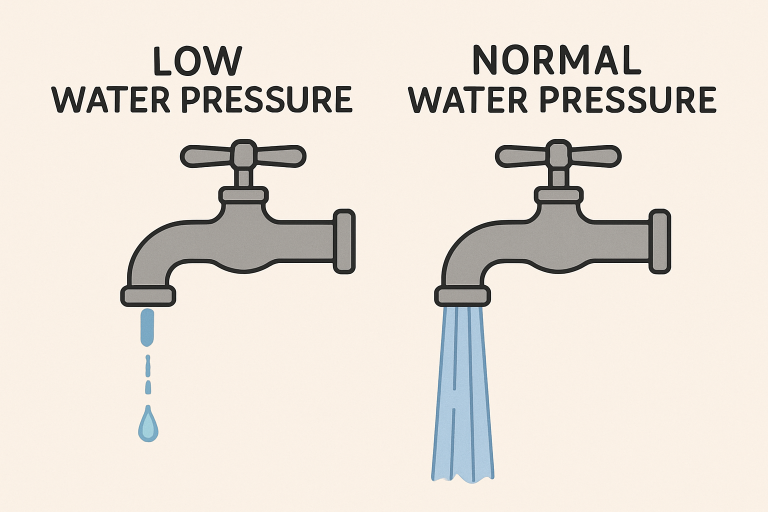Why your water pressure might be low and how to fix it
Key takeaways
- Water pressure affects daily convenience, appliance efficiency, and overall plumbing performance.
- Low pressure can result from old or corroded pipes, clogged fixtures, leaks, pressure regulator issues, or municipal water disruptions.
- Testing water pressure at home helps identify problems early; the normal range is 40–60 psi.
- DIY fixes include cleaning aerators, checking for leaks, adjusting regulators, and flushing the water heater.
- Persistent or unexplained issues require professional plumbing services for safe, long-term solutions.
- Preventative maintenance—regular inspections, pipe upgrades, and fixture care—helps maintain consistent pressure and prevents costly repairs.
What is water pressure and why does it matter?
Water pressure is the force that pushes water through the pipes in your home. It influences how quickly and forcefully water flows from your taps, showerheads, and appliances. In most households, proper water pressure is essential for everyday convenience—think of invigorating showers, fast-filling bathtubs, and appliances running efficiently.
For residents facing urgent or unexplained low water pressure, contacting emergency plumbing in Manasquan, NJ can help address the issue quickly and safely. Aside from inconvenience, inadequate pressure can strain water-dependent appliances and even lead to higher water bills if leaks are involved. When low pressure persists, it may point to inefficiencies that could worsen over time, potentially causing avoidable repairs or replacements.
The most common causes of low water pressure
Several factors may be behind low water pressure in your home. Understanding these common causes is the first step toward a solution:

- Issues with supply pipes: Old, corroded, or undersized pipes can restrict water flow.
- Clogged fixtures: Mineral deposits and sediment in faucets, showerheads, or aerators can reduce flow at the point of use.
- Leaky or corroded plumbing: Undetected leaks or internal pipe corrosion are frequent culprits, reducing available pressure.
- Municipal water disruptions: Sometimes the problem lies outside your home, such as city water main breaks, routine maintenance, or fire hydrant use.
- Pressure regulator issues: Homes with pressure-reducing valves can experience low pressure if the regulator malfunctions or is improperly set.
How to check your home’s water pressure
Testing your home’s water pressure is straightforward. First, secure a water pressure gauge (available at most hardware stores). Attach the gauge to your washing machine’s outside hose spigot or the cold-water line. Turn off all running water inside and outside the house before testing for an accurate reading.
A typical reading should range between 40 and 60 psi (pounds per square inch). Anything below 40 psi is usually considered low and warrants further inspection.
DIY fixes for boosting water pressure
Several simple at-home solutions can resolve inadequate water pressure:
- Clean aerators and showerheads: Unscrew and soak them in vinegar overnight to dissolve mineral buildup.
- Check for leaks: Inspect exposed pipes and connections, especially in basements and under sinks, for signs of leakage.
- Adjust the pressure regulator: If your home has a regulator, carefully increase the setting in small increments.
- Flush your water heater: Sediment accumulation can reduce flow. Flushing the tank at least once a year can help maintain pressure and prolong the water heater’s life.
When to call in a professional
While many low water pressure problems can be fixed with simple solutions, some require a professional plumber. Detecting unexplained wet patches, mold, or a sudden and severe drop in pressure could indicate a break or blockage hidden behind walls or below the foundation. Homes with older or complex plumbing systems may also have unsafe or impractical issues for DIY repairs.
Calling a plumbing expert ensures safe, long-term solutions and compliance with local codes. A professional plumber can diagnose problems beyond the obvious, such as underground leaks or deteriorating pipes needing replacement.
Preventing future water pressure problems
Preventative care is the key to long-lasting water pressure. Regularly clean fixtures, monitor for drips and unexplained moisture, and flush your water heater annually to remove sediment. Consider replacing older pipes with modern materials like PEX or copper, less prone to corrosion and buildup.
Regular plumbing inspections can catch small issues before they escalate, helping you maintain optimal water pressure and avoid costly repairs.
The link between plumbing health and water pressure
The overall health of your plumbing system directly affects water pressure. Aging pipes, mineral buildup, and hidden leaks can slowly erode pressure levels. Keeping your plumbing up-to-date and addressing minor issues before they escalate ensures a strong, consistent flow throughout your home. Upgrading outdated piping and fixtures can make a significant difference for water pressure, water quality, and household safety.
How nationwide water conservation efforts can affect local water pressure
Water conservation programs influence water pressure on a municipal and household level. As communities invest in conservation ordinances and install pressure-limiting devices, some homes may experience changes in pressure. However, there are practical ways to save water without sacrificing performance. Select low-flow fixtures designed to preserve pressure, repair leaks promptly, and avoid excessive simultaneous water use.




